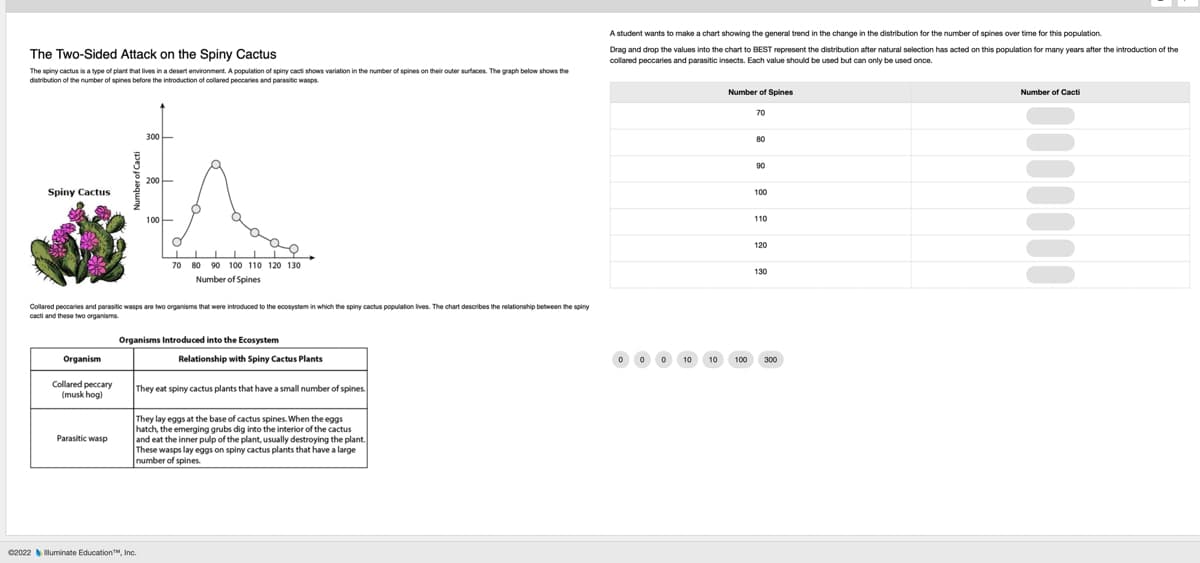The Two-Sided Attack on the Spiny Cactus The spiny cactus is a type of plant that lives in a desert environment. A population of spiny cact shows variation in the number of spines on their outer surfaces. The graph below shows the distribution of the number of spines before the introduction of collared peccaries and parasitic wasps Spiny Cactus Organism Collared peccaries and parasitic wasps are two organisms that were introduced to the ecosystem in which the spiny cactus population lives. The chart describes the relationship between the spiny cact and these two organisms Collared peccary (musk hog) 100- Parasitic wasp LUL 70 80 90 100 110 120 130 Number of Spines Organisms Introduced into the Ecosystem Relationship with Spiny Cactus Plants They eat spiny cactus plants that have a small number of spines. They lay eggs at the base of cactus spines. When the eggs hatch, the emerging grubs dig into the interior of the cactus and eat the inner pulp of the plant, usually destroying the plant These wasps lay eggs on spiny cactus plants that have a large number of spines A student wants to make a chart showing the general trend in the change in the distribution for the number of spines over time for this population. Drag and drop the values into the chart to BEST represent the distribution after natural selection has acted on this population for many years after the introduction of the collared peccaries and parasitic insects. Each value should be used but can only be used once. Number of Spines 70 80 90 100 110 120 130 Number of Cacti
The Two-Sided Attack on the Spiny Cactus The spiny cactus is a type of plant that lives in a desert environment. A population of spiny cact shows variation in the number of spines on their outer surfaces. The graph below shows the distribution of the number of spines before the introduction of collared peccaries and parasitic wasps Spiny Cactus Organism Collared peccaries and parasitic wasps are two organisms that were introduced to the ecosystem in which the spiny cactus population lives. The chart describes the relationship between the spiny cact and these two organisms Collared peccary (musk hog) 100- Parasitic wasp LUL 70 80 90 100 110 120 130 Number of Spines Organisms Introduced into the Ecosystem Relationship with Spiny Cactus Plants They eat spiny cactus plants that have a small number of spines. They lay eggs at the base of cactus spines. When the eggs hatch, the emerging grubs dig into the interior of the cactus and eat the inner pulp of the plant, usually destroying the plant These wasps lay eggs on spiny cactus plants that have a large number of spines A student wants to make a chart showing the general trend in the change in the distribution for the number of spines over time for this population. Drag and drop the values into the chart to BEST represent the distribution after natural selection has acted on this population for many years after the introduction of the collared peccaries and parasitic insects. Each value should be used but can only be used once. Number of Spines 70 80 90 100 110 120 130 Number of Cacti
Biology Today and Tomorrow without Physiology (MindTap Course List)
5th Edition
ISBN:9781305117396
Author:Cecie Starr, Christine Evers, Lisa Starr
Publisher:Cecie Starr, Christine Evers, Lisa Starr
Chapter16: Population Ecology
Section: Chapter Questions
Problem 1DID
Related questions
Question
100%

Transcribed Image Text:The Two-Sided Attack on the Spiny Cactus
The spiny cactus is a type of plant that lives in a desert environment. A population of spiny cact shows variation in the number of spines on their outer surfaces. The graph below shows the
distribution of the number of spines before the introduction of collared peccaries and parasitic wasps.
Spiny Cactus
Organism
Collared peccary
(musk hog)
Collared peccaries and parasitic wasps are two organisms that were introduced to the ecosystem in which the spiny cactus population lives. The chart describes the relationship between the spiny
cacti and these two organisms
Parasitic wasp
100-
o
70 80 90 100 110 120 130
Number of Spines
Organisms Introduced into the Ecosystem
C2022 Iluminate Education, Inc.
Relationship with Spiny Cactus Plants
They eat spiny cactus plants that have a small number of spines.
They lay eggs at the base of cactus spines. When the eggs
hatch, the emerging grubs dig into the interior of the cactus.
and eat the inner pulp of the plant, usually destroying the plant.
These wasps lay eggs on spiny cactus plants that have a large
number of spines.
A student wants to make a chart showing the general trend in the change in the distribution for the number of spines over time for this population.
Drag and drop the values into the chart to BEST represent the distribution after natural selection has acted on this population for many years after the introduction of the
collared peccaries and parasitic insects. Each value should be used but can only be used once.
Number of Spines
70
80
90
100
110
120
130
Number of Cacti
Expert Solution
This question has been solved!
Explore an expertly crafted, step-by-step solution for a thorough understanding of key concepts.
This is a popular solution!
Trending now
This is a popular solution!
Step by step
Solved in 2 steps

Knowledge Booster
Learn more about
Need a deep-dive on the concept behind this application? Look no further. Learn more about this topic, biology and related others by exploring similar questions and additional content below.Recommended textbooks for you

Biology Today and Tomorrow without Physiology (Mi…
Biology
ISBN:
9781305117396
Author:
Cecie Starr, Christine Evers, Lisa Starr
Publisher:
Cengage Learning

Biology Today and Tomorrow without Physiology (Mi…
Biology
ISBN:
9781305117396
Author:
Cecie Starr, Christine Evers, Lisa Starr
Publisher:
Cengage Learning